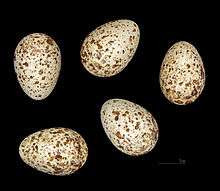Calandra lark
| Calandra lark | |
|---|---|
 | |
| Scientific classification | |
| Kingdom: | Animalia |
| Phylum: | Chordata |
| Class: | Aves |
| Order: | Passeriformes |
| Family: | Alaudidae |
| Genus: | Melanocorypha |
| Species: | M. calandra |
| Binomial name | |
| Melanocorypha calandra (Linnaeus, 1766) | |

The calandra lark (Melanocorypha calandra) breeds in warm temperate countries around the Mediterranean and eastwards through Turkey into northern Iran and southern Russia. It is replaced further east by its relative, the bimaculated lark. The current genus name, Melanocorypha is from Ancient Greek melas, "black", and koruphos a term used by ancient writers for a now unknown bird, but here confused with korudos, "lark". "Calandra"' derives ultimately from kalandros the Ancient Greek name for this bird.[2][3]
It is mainly resident in the west of its range, but Russian populations of this passerine bird are more migratory, moving further south in winter, as far as the Arabian peninsula and Egypt. It is a very rare vagrant to western Europe.
This is a bird of open cultivation and steppe. Its nest is on the ground, with 4–5 eggs being laid. Food is seeds supplemented with insects in the breeding season. It is gregarious outside the breeding season.
This is a large, robust lark, 17.5–20 cm long. It is an undistinguished-looking species on the ground, mainly streaked greyish brown above and white below, and with large black patches on the breast sides. It has a white supercilium.
In flight it shows short broad wings, which are dark below, and a short white-edged tail. The wing and tail patterns are distinctions from its more easterly relatives.
The song is like a slower version of that of the skylark, so musical to human ears that the calandra lark was formerly a popular cagebird in its range.[4] It is mentioned in, for instance, the Tuscan proverb "Canta come una calandra", he or she sings like a lark,[5] and the Spanish ballad "Romance del prisionero", where its song is the only way the prisoner knows when day breaks.[6]
Parasites of the calandra lark include the chewing louse (Ricinus vaderi Valan, 2016), described from specimens collected in Azerbaijan.[7]
References
- ↑ BirdLife International (2012). "Melanocorypha calandra". IUCN Red List of Threatened Species. Version 2013.2. International Union for Conservation of Nature. Retrieved 26 November 2013.
- ↑ Jobling, James A (2010). The Helm Dictionary of Scientific Bird Names. London: Christopher Helm. pp. 84, 247. ISBN 978-1-4081-2501-4.
- ↑ "Calandra". Oxford English Dictionary (3rd ed.). Oxford University Press. September 2005. (Subscription or UK public library membership required.)
- ↑ Kikkawa, Jiro (2003). "Larks". In Perrins, Christopher (editor). Firefly Encyclopedia of Birds. Firefly Books. pp. 578–583. ISBN 1-55297-777-3.
- ↑ Giusti, Giuseppe (1853). Raccolta di proverbi toscani. F. Monnier. p. 364. Retrieved 2008-06-21.
- ↑ Stanley, ed. (2004). Spanish Traditional Ballads/Romances Viejos Españoles. Translated by Applebaum. Courier Dover Publications. pp. 214–215. ISBN 0-486-42694-7. Retrieved 2008-06-21.
- ↑ Valan, Miroslav; Sychra, Oldrich; Literak, Ivan (2016). "Chewing lice of genus Ricinus (Phthiraptera, Ricinidae) deposited at the Zoological Institute of the Russian Academy of Sciences, Saint Petersburg, Russia, with description of a new species". Parasite. 23: 7. doi:10.1051/parasite/2016007. ISSN 1776-1042.

